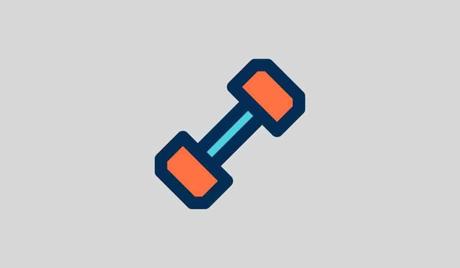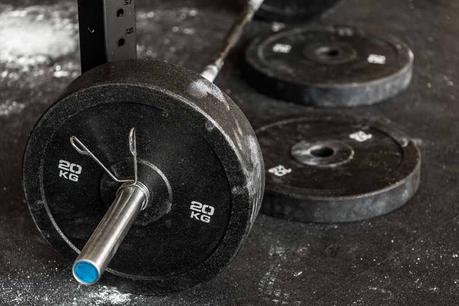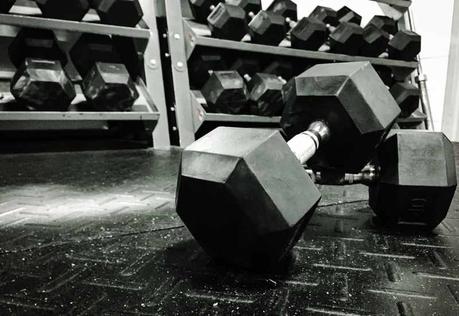Dumbbell or barbell: who is king? Read on for a detailed breakdown of both, what’s better for your workouts, and why both can help you ultimately win in the gym.

One of the most consistent debates in the gym is the best form of resistance.
It’s not enough that we argue endlessly about rep ranges, technique, and preworkout brands, we also need to debate the best type of weight resistance.
When it comes to free weights (I’m not going to touch the debate of free weights vs machines in this post), there are two main options…
Barbells or dumbbells.
The truth is, they BOTH belong in any serious workout regimen.
After all, why not leverage the strengths of both tools to help you speed faster towards your workout goals?
In this friendly debate between barbells vs dumbbells, we will take a look at the key differences, strengths, disadvantages, and more.
- Benefits of Barbells
- Types of Barbells
- Benefits of Dumbbells
- Types of Dumbbells
- Barbells vs. Dumbbells – FAQs
- Why do dumbbells feel heavier than barbells?
- Can you replace barbells with dumbbells?
My hope is that by more fully appreciating the strengths (and weaknesses) of both types of resistance, the real winner will be you.
Let’s jump right in.
Benefits of Barbells
Barbells are made for big weight, and for this reason, it’s why you see them in competitive situations such as Olympic weightlifting, powerlifting, CrossFit events, the NFL Combine, and so on.
Essentially an extended dumbbell, resistance comes in the form of weight plates that are loaded onto the sleeve and then locked into place with a barbell collar.

Barbells are long, ranging anywhere from 6 to 7ft, made of steel, and the weight of a barbell also ranges a little, typically weighing 45lbs.
Here are the benefits of training with a barbell at the gym:
Barbells load more weight.
Barbells are made to pack on a lot of weight. With long sleeves on either end, you can fit a whole bunch of weight plates, especially cast iron weight plates, which are thinner than bumper plates.
If you want to go heavy, you want to go with a barbell. The weight range is simply higher.
No matter how strong you get, with dumbbells, you are going to cap out with weight. Eventually they become too unwieldy for most lifters.
With barbells, however, the sky is almost the limit, with competition and powerlifting barbells capable of holding 1,500lbs or more.
Peak power.
To piggyback on the previous point, barbells also allow you to exert more power compared to dumbbells.
This is mainly because there is less stabilization work required when holding a barbell, allowing you to concentrate all of your energy and power into the lift.
Holding onto multiple weights (as you do with dumbbells) takes up a lot of energy as you are trying to stabilize and balance two weights compared to one when using a barbell.
This can work out to be a benefit for people training for specific goals, as we will discuss later in the benefits of dumbbells section, but when it comes to getting every last bit of power out of you, using a barbell is the way to go.
Ideal for squats.
Back squats are the king of lower body exercises. You know it, I know.
Because you load the barbell with plates, and rest it on your traps, you can focus exclusively on dominating the lift. It’s all quads, baby!
Dumbbells are a little more challenging to hold onto and can drain your shoulders and forearms—especially as you get heavy with weight—making barbells a better choice for squats.
Rack utilization.
While I prefer dumbbells for a lot of lifts when training by myself (because it’s easier to ditch them when pushing to failure), there are some options for lifting heavy with barbells that keeps things safe and gives you peace of mind.
Most squat racks have safety pins (or my new favorite—spotter straps) that catch the weight should you fail a lift.
Racks also have J-cups where you can park a loaded barbell between sets or use the cups as the starting position for presses (versus dumbbells, which you will have to pick up off the floor each time you start a new set).
More knurling options.
This perk is mainly for powerlifters, who want extra grip on the barbell in the form of deeper knurling.
Knurling is the diamond-treaded pattern on barbells. A more aggressive knurl—which makes it deeper—is designed for maximum grip.
The benefits of deep knurling evaporate quickly after a few repetitions, with the tread digging in and ripping at the skin.
Barbells come in a wide variety of knurling, from a flat chrome finish to medium and heavy knurling. And while dumbbells often have some knurling, it’s never aggressive and always limited in choice.
Types of Barbells
Barbells are similar in general function.
Hold some weight plates and be comfortable enough to hold that we can focus on lifting with proper technique and nothing else.
But barbells come in a variety of shapes and secondary functions.
They include:




There are also Swiss bars, safety squat bars, and much more, all tailored for specific purposes and jobs.
Benefits of Dumbbells
Dumbbells are essentially a shortened barbell. They come in a variety of shapes and formats (loadable, fixed, etc) and are wildly versatile pieces of strength training equipment.
Here are some of my favorite things about training with dumbbells:
Train with different angles.
Barbells are excellent for maximum weightlifting as they stabilize the weight so you can drive all of your energy into one direction. But with all of that power comes a limitation in the number of directions you can (safely) move it.
Dumbbells allow you to change the angles and directions of your lifting movements, making them much more ideal for lateral training (side to side lunges and squats, for example).

Portable.
Barbells are unwieldy. Usually around 7-feet in length, you are limited in their use outside of the squat rack or lifting platform.
Dumbbells are excellent for traveling, working out in the backyard, or in smaller workout areas (adjustable dumbbells, in particular, are mega space savers).
For exercises that require movement (like a Farmer’s walk), or home gyms very tight on space, or for people who travel a lot, dumbbells are a no-brainer.
Stability.
While barbells work a lot of the smaller stabilizer muscles, dumbbells take it to another level. Because you are trying to keep two separate weights balanced and aligned, all of the smaller stabilizer muscles are working overtime to keep your technique together.
This is one of the reasons I argue that athletes should lean more towards dumbbells as they are more functional and dynamic.
The added effort stabilizing the dumbbells doesn’t come without a cost, however, with your muscles expending energy and reducing the overall amount of weight you can lift.
Unilateral training.
We all have a dominant side. Using a barbell or machine can gloss over this fact. With a dumbbell, you can truly see that one side of your body is stronger.
Dumbbells give you the opportunity to really focus on BOTH sides. Muscle imbalances are a real thing in the gym—the lifter who comes out of a squat with a loaded barbell that is titled, for example—and using dumbbells is an immediate way to address and improve muscle imbalances.
Additionally, muscle imbalances are a leading cause of injury in the weight room, and tacking on some dumbbell work can help mitigate some of this risk.
Range of motion 9000.
One of the reasons that I love cable machines so much (I know, I know—I promised not to bring machines into the mix!) is that they are monsters at extending range of motion in a lot of lifts.
Dumbbells are very similar in this regard, giving you a wider range of motion, which immediately translates into more muscle activation. More muscle activation, more muscle growth.
Types of Dumbbells
Although the general function of a dumbbell remains the same—be heavy and provide resistance—the structure and materials used in their construction vary widely.
Here’s a brief overview of the different types of dumbbells and the benefits of each.




Barbells vs. Dumbbells – FAQs
Why do dumbbells feel heavier than barbells?
This comes down to how much stress your body is under when trying to stabilize dumbbells.
Think about it: with a barbell, your arms can compensate for one another, and you are only trying to stabilize one weight.
When you have a pair of dumbbells in your hands, the energy demand goes up.
Your stabilizer muscles are going bonkers trying to keep two weights in proper position.
Can you replace barbells with dumbbells?
This comes down to what your goals are in the gym.
Back in my competitive swimming days, when it was bench press day, I stuck to alternating dumbbell bench press because the dumbbell version was easier on my shoulders, I could use a more natural grip, and it required my core to work at level ten to keep me on the bench.
Things that all translated well to what I was trying to do in the water as an athlete.
If you are a competitive powerlifter, barbells are going to be a must. Train as you compete, as they say.
But for the majority of us who are simply looking for a way to build muscle mass, dumbbells are just as effective.
And in the cases of people who train solo, want to use a more natural grip, and want a safer way to ditch weight, dumbbells present a distinct advantage.
More Guides Like This
Olympic Barbells vs Powerlifting Bars – What’s the Difference? Curious about the difference between powerlifting and Olympic barbells? Here’s a detailed look at what you need to know.
7 Best Dumbbells for Home Gyms. Looking for the best dumbbells for your home workouts? Get stronger and fitter with the best dumbbells for every budget and type of lifter.
